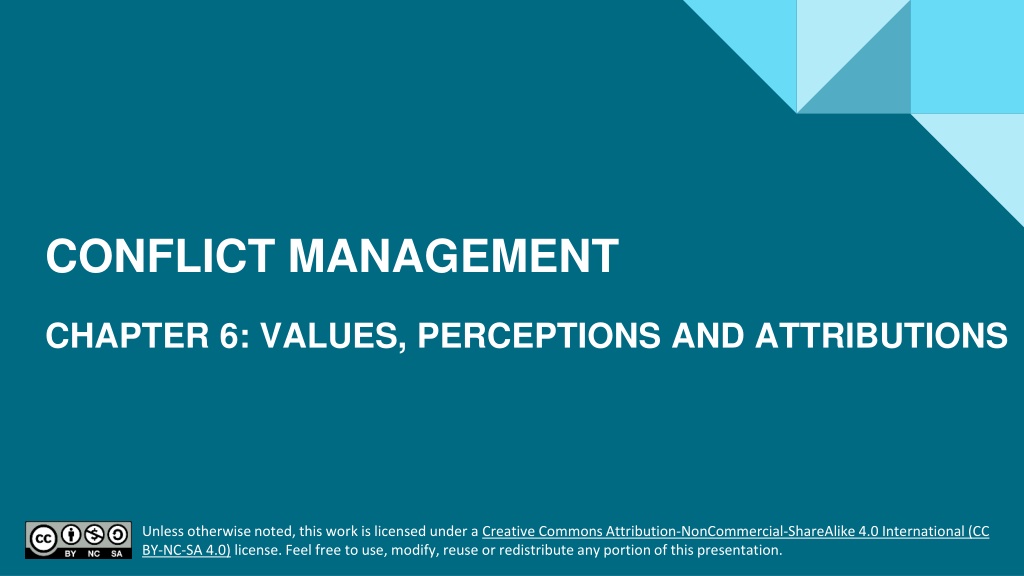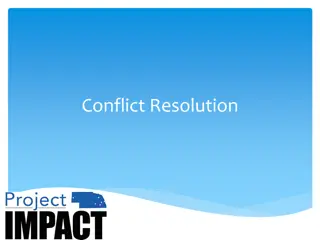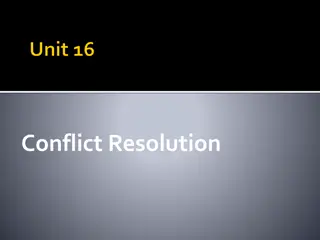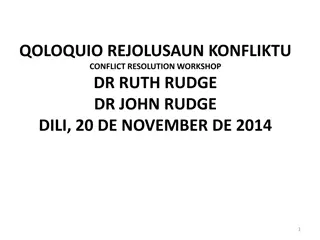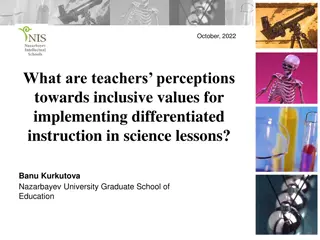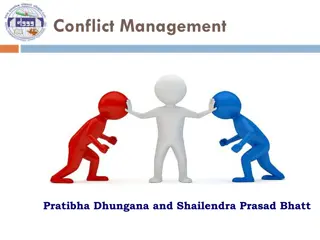Understanding Values, Perceptions, and Attributions in Conflict Management
Values, perceptions, and attributions play key roles in conflict management. Values shape behaviors, perceptions guide how we interpret information, and attributions help us understand causes of events. This chapter explores how these factors influence interpersonal interactions and offers strategies for accurate self and other perception.
Uploaded on Sep 17, 2024 | 0 Views
Download Presentation

Please find below an Image/Link to download the presentation.
The content on the website is provided AS IS for your information and personal use only. It may not be sold, licensed, or shared on other websites without obtaining consent from the author. Download presentation by click this link. If you encounter any issues during the download, it is possible that the publisher has removed the file from their server.
E N D
Presentation Transcript
CONFLICT MANAGEMENT CHAPTER 6: VALUES, PERCEPTIONS AND ATTRIBUTIONS Unless otherwise noted, this work is licensed under a Creative Commons Attribution-NonCommercial-ShareAlike 4.0 International (CC BY-NC-SA 4.0) license. Feel free to use, modify, reuse or redistribute any portion of this presentation.
Learning Outcomes Upon successful completion of this chapter, you will be able to: Define values. Describe how values influence our behaviours. Define perception. Identify how salience influences the selection of perceptual information. Recognize ways in which we organize perceptual information. Describe the role of schemata in the interpretation of perceptual information. Define attribution. Compare between internal and external attributions. Explain the fundamental attribution error and the self-serving bias. Identify the influence that our values have on our behaviours. Review strategies for perceiving the self and others more accurately. Use perception checking to improve perception of self and others.
6.1 Values I A value may be defined as an enduring belief that a specific mode of conduct or end-state of existence is personally or socially preferable to an opposite or converse mode of conduct or end-state of existence. (Rokeach, 1973, p. 5).
6.1 Values II The values people have tend to be relatively stable over time. The reason for this lies in the manner in which values are acquired in the first place. That is, when we first learn a value (usually at a young age), we are taught that such-and-such behavior is always good or always bad. Image by Pete Linforth from Pixabay
6.1 Values III Values and Workplace Behaviour The values a person holds will affect their employment. In terms of work behaviors, a person is more likely to accept a job offer when the company possesses the values he or she cares about. A firm s values are often described in the company s mission and vision statements, an element of the Planning function (Judge & Bretz, 1992; Ravlin & Meglino, 1987).
6.2 Perceptions Perception is the process of selecting, organizing, and interpreting information.
6.3 Attributions I Attribution theory concerns the process by which an individual interprets events as being caused by a particular part of a relatively stable environment (Kelly, 1980, p. 193).
6.3 Attributions II The Attribution Process
6.3 Attributions III Internal and External Causes of Behavior
6.4 Examining our Perceptions in Conflict I In the perceptual process, several barriers can be identified that inhibit the accuracy of our perception. These barriers are biases, selective perception, and perceptual defense. These barriers to accurate perceptions can be present in many situations, including conflict. Being aware of our own biases can help us to critically examine our own perceptions .
6.4 Examining our Perceptions in Conflict II Biases Biases are shortcuts our brain forms based on culture, our own experiences, things other people tell us, and institutional influences. Often, unconscious bias can be difficult to spot because it is not the same as explicit bias or blatant bigotry. Image: Trecia McLennon. Intercultural Awareness and Competence, 2021. CC BY 4.0.
6.4 Examining our Perceptions in Conflict III Selective Perception Selective perception is the process by which we systematically screen out information we don t wish to hear, focusing instead on more salient information. Saliency here is obviously a function of our own experiences, needs, and orientations.
6.4 Examining our Perceptions in Conflict IV Perceptual Defense Perceptual defense is founded on three related principles: 1. Emotionally disturbing or threatening stimuli have a higher recognition threshold than neutral stimuli. 2. Such stimuli are likely to elicit substitute perceptions that are radically altered so as to prevent recognition of the presented stimuli. 3. These critical stimuli arouse emotional reactions even though the stimuli are not recognized.
6.4 Examining our Perceptions in Conflict V Perception Checking Through perception checking, we describe what we perceive the other person to be thinking or feeling and then request clearly and in a non-threatening manner that the other person confirms or corrects our perception.
6.4 Examining our Perceptions in Conflict VI Steps in Perception Checking Step 1: Describe the behavior or situation without evaluating or judging it. Perception checks include I language and a clearly stated observation or fact: I heard you mention ____. Step 2: Think of some possible interpretations of the behavior, being aware of attributions and other influences on the perception process. This is followed by 2 possible interpretations: I am wondering if ___ or ___ is the case for you? Step 3: Verify what happened and ask for clarification from the other person s perspective. Be aware of punctuation, since the other person likely experienced the event differently than you. The perception check is completed with a clarification request: Can you clarify?
6.5 Key Takeaways Values are relatively stable over time and guide our behaviour. Perception is the process of selecting, organizing, and interpreting information. Given the massive amounts of stimuli taken in by our senses, we only select a portion of the incoming information to organize and interpret. We organize information that we select into patterns based on proximity, similarity, and difference. We interpret information using schemata, which allow us to assign meaning to information based on accumulated knowledge and previous experience. We use attributions to interpret perceptual information, specifically, people s behavior. Two common perceptual errors that occur in the process of attribution are the fundamental attribution error and the self-serving bias. Barriers to accurate perception include stereotyping, selective perception and perceptual defense. Perception checking is a strategy that allows us to monitor our perceptions of and reactions to others and communication. We can improve our perceptions using a number of suggestions
